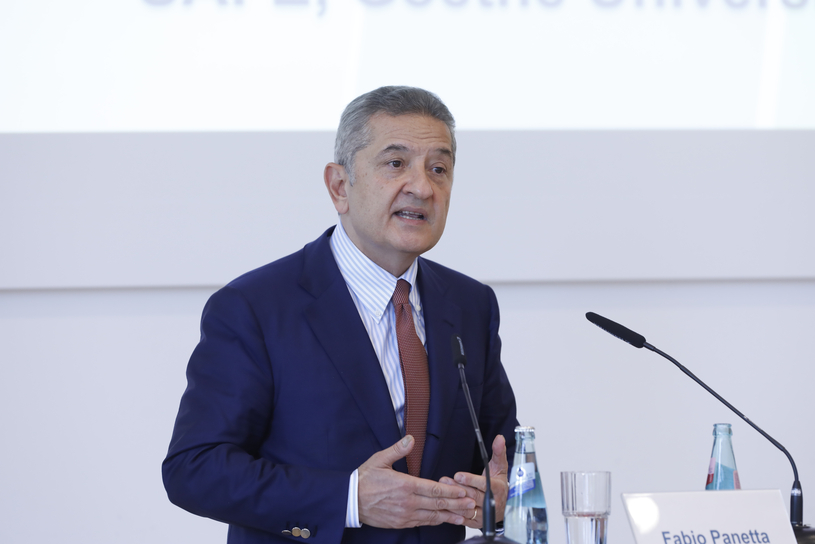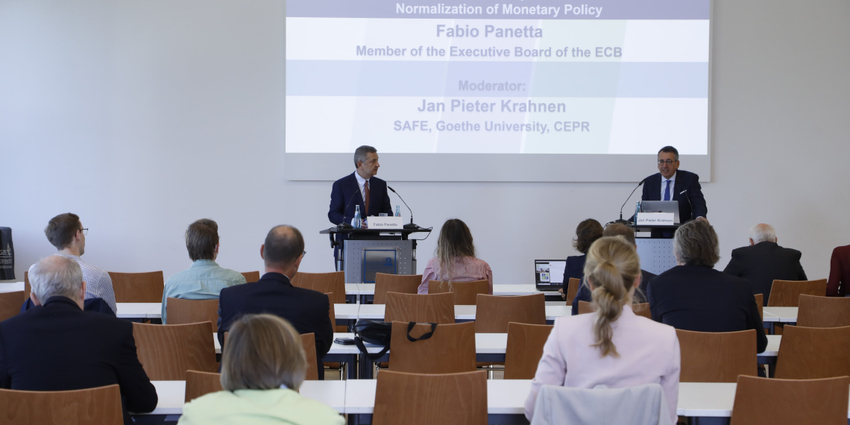In the light of multiple worldwide crises, inflation rates rise, energy prices are on the surge, and ongoing geopolitical conflicts cause calls for a normalization of the ECB’s monetary policy to get louder. ECB board member Fabio Panetta emphasized the importance of gradual implementations to reach a medium-term inflation goal of two percent in a joint Policy Lecture of the Leibniz Institute for Financial Research SAFE and the Centre for European Policy Research on 25 May 2022, moderated by SAFE Director Jan Pieter Krahnen.
According to Panetta, unlike other advanced economies, the Euro area finds itself in a difficult situation. In addition to global supply shocks due to the Corona pandemic, a war at its doorstep causes huge increases in energy prices. “This leads to upward pressures on near-time inflation, which then affects post-pandemic recovery,” he said.
To strengthen the Euro area economy, Panetta suggested normalizing monetary policy. However, he outlined that normalization needs to be carefully calibrated. From his perspective, the process of normalization occurs when the central bank adjusts its policy parameters to stabilize its medium-term target of reaching a two percent inflation rate by 2024. In his speech, the ECB Director pointed out that three distinctions about the normalization of monetary policy are necessary.
First, normalization cannot be defined as a neutral policy stance that occurs when monetary policy is neither accommodated nor contradictory to the economy. The neutral stance allows the ECB to stabilize inflation rates around the perceived target when there are no transitory shocks that could cause disruption. “Yet, we currently find ourselves in a situation in which there are depressing shocks to the economy and the level of uncertainty is at a high degree,” argued Panetta.
Second, he mentioned that the normalization process should not be assessed against unobservable reference points such as a neutral interest rate and an optimal size of the central bank’s balance sheets in the long run. Arguably, these reference points can only function as vague guideposts and not as guidelines for policy due to their unpredictability. According to Panetta, the third point which needs to be considered is that normalization does not imply the use of only unconventional measures but also conventional ones. The balance between these measures forms a necessary toolkit in the ECB’s decision-making process to deliver the necessary policy stands to reach a presumed medium-term inflation target of two percent.

As Panetta further explained, there are various ways the ECB could reach its respective target by 2024 but the calibrating process within the Euro area is extremely complex. Two necessary components of normalization need to be weighed against each other with the first being gradualism. “Especially in uncertain times like these, making gradual steps towards normalization of monetary policy is an appropriate measure today for the outlook of the economic activity,” he illustrated.
Second, robustness helps to define the gradual pace of normalization. As the global economy has faced many supply shocks, especially in the energy sector due to the war and zero-Covid policies in China, Panetta mentioned, that the observed shocks get prolonged and amplified, thus causing higher import costs and inflation rates to rise. To normalize monetary policy, the ECB needs to adjust and calibrate its goal wisely by reducing the risk of overcorrection, which allows for faster decision-making. As he finally argued, to reach its inflation target of two percent by 2024, the ECB needs to choose its measures gradually and steadily.


